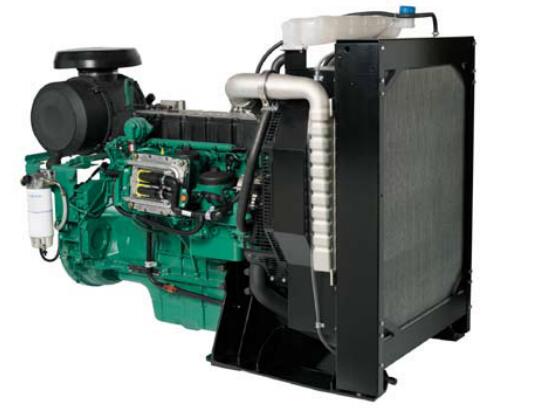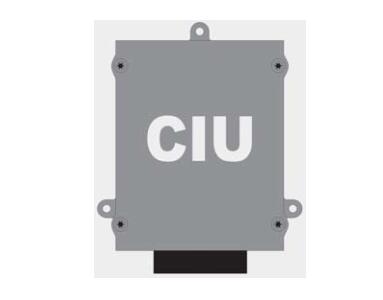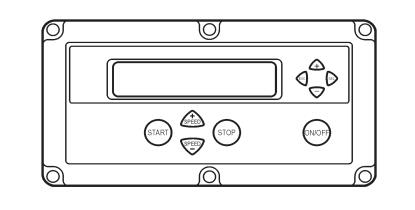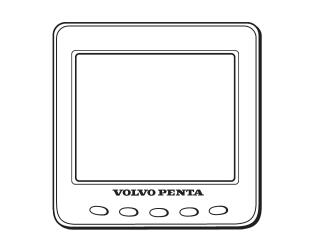Volvo Penta TAD734GE is a powerful, reliable and economical Generating Set Diesel Engine built on the dependable in-line six design.
Features
– Electronic governing, EMS2
– CAN bus communication
– Compact design for the power class – High power to weight ratio
– Emission compliant
– Noise optimized engine design
– Dual speed

EMS 2 is an electronic system with CAN communication (Controller Area Network) for controlling diesel engines. The system has been developed by Volvo and includes fuel regulation and diagnostic functions.
The system comprises a control unit, six injectors, a number of sensors that supply the control unit with values and connectors for diagnostics and functional checks. The engine can be connected to a communication interface comprising a CAN link and a serial link.
The CAN link J1939 is responsible for all communication between the engine control unit (EMS 2) and a communication interface (such as CIU/DCU) with the exception of diagnostics. Diagnostics is handled by the J1708/J1587 link. The CAN link is much faster than the J1708/J1587 link and has been constructed for connection to other components that support the SAE J1939 protocol, such as instrument panels and transmissions.
If a fault occurs in the CAN link, the signals from the engine speed potentiometer and start and stop but-tons are taken over by the J1708/J1587 link. However, the instruments and tell-tale lamps are shut down. If faults occur on both links, the engine will run at idle. In such a situation, the engine can only be shut down by using the auxiliary stop (AUX-STOP) located on the left of the engine.
The CIU is a “translator” between the CAN bus and the customer’s own control panel. The unit has two serial communication links, a fast one and a slow one.
The fast link is the CAN link which offers a speed of 250 Kbit/s. All data concerning instruments, tell-tale lamps, connectors and potentiometers is transferred via this bus.
The slower link, J1708/1587 handles diagnostic information such as flash-codes. The diagnosis tool VODIA also uses the J1708/J1587 link to communicate with the system.

The DCU is a digital instrument panel that communicates with the engine control unit via the CAN link. The DCU has several functions, such as:
Engine control
– Start, stop, engine speed regulation, pre-heating, etc.
Monitoring
– Engine speed, charge pressure, charge air temperature, coolant temperature, oil pressure, oil temperature, operating hours, battery voltage, instantaneous fuel consumption and fuel consumption (trip fuel).
Diagnostics
– Shows fault codes in text. Lists previous faults.
Parameter setting
– Idle speed, alarm limits for oil temperature/coolant temperature, speed drop.
– Pre-heating before ignition.
Information
– Information about hardware, software and engine identification.

The DU is an instrument panel that shows the engine’s working values in graphical form on an LCD display. It consists of an computerized unit for permanent installation in a control panel.
The display communicates via the CAN link. It is connected to the CAN link between the engine control unit and the CIU or DCU.
Monitoring
– Engine speed, charge pressure, charge air temperature, coolant temperature, oil pressure, oil temperature, fuel pressure, operating hours, battery voltage, instantaneous fuel consumption and fuel consumption (trip fuel).
Diagnostics
– Shows active fault codes as text.

The engine’s fuel requirement is analyzed up to 100 times per second (depending on engine rpm). The engine’s injection volume and injection timing are controlled electronically via the fuel valves in the injectors.
This means that the engine always has the correct fuel volume under all running conditions, which gives lower fuel consumption, the smallest possible exhaust emission, etc.
The control unit controls and regulates the injectors connected to a common rail, to ensure that the correct fuel volume is injected into each cylinder. It also calculates and adjusts the injection timing. Regulation is performed mainly by using the engine speed sensor and combination sensor for charge air pressure/charge air temperature.
The control unit effects the unit injectors via an electronic signal to the solenoid fuel valve in each unit injector, which can be opened and closed.
When the fuel valve is open, the fuel flows past, through the hole in the unit injector and out via the fuel channel. In this state, no fuel is injected into the cylinders.
When the fuel valve is closed, pressure is built up by the mechanically driven piston in the unit injector. When sufficient pressure has been built up, the fuel is injected into the cylinder via the unit injector’s injector. The fuel valve opens again and the pressure in the unit injector drops at the same time as injection into the cylinder stops.
In order to decide when the fuel valve shall open and close, the control unit has access to signals from sensors and monitors.
The control unit calculates the volume of fuel to be injected into the cylinder. The calculation determines the time during which the fuel valve is closed (when the fuel valve is closed, fuel is injected into the cylinder). The parameters that determine the volume of fuel injected are:
• Requested engine speed
• Engine protection functions
• The temperature
• Charge air pressure
The control unit contains an air pressure sensor and high altitude compensation for engines operating at high altitudes.
The function limits the fuel volume in relation to the ambient air pressure (the engine output is reduced from approx. 1500 meters altitude). This is done to prevent smoking, high exhaust temperatures and to protect the turbocharger for over-speeding.
The purpose of the diagnostic function is to detect and localize any faults in the EMS 2 system, to protect the engine and inform about any problems that may occur.
If a fault is detected, this is shown with a warning lamp, a flashing diagnostic lamp or a text message on the instrument panel, depending on the type of equipment fitted. If a fault code is displayed as a flash code or as text, this information is used as a guide when fault tracing. Fault codes can also be read off by Volvo VODIA tool at authorized Volvo Penta workshops.
If a serious fault occurs, the engine may be shut down completely or the control unit may reduce the power output (depending on the application). A fault code is also displayed for guidance when fault tracing.
● Maximum cable length 8 meters (4 meters from connector and back).
● Minimum cable cross-section 2.5 mm2
● Never use the “AUX-STOP” as the normal stop button.
● It is not permitted to use the “AUX-STOP” at the same time as the normal stop button*.
● If an emergency stop is fitted, we cannot guarantee that the EMC requirements are fulfilled, since this can effect how the the cabling is connected.
*NOTE! If the ”AUX-STOP is used at the same time as the normal stop button, the Common Rail system may be seriously damaged.
Engine designation | |||
No. of cylinders and configuratio | in-line 6 | ||
Method of operation | 4-stroke | ||
Bore x Stroke (mm) | 108 x 130 | ||
Displacement (L) | 7.15 | ||
Compression ratio | 17:1 | ||
Dry weight, excl. cooling system, kg (lb) | 764 (1684) | ||
Wet weight, excl. cooling system, kg (lb) | 788 (1737) | ||
Performance | 1500 rpm | 1800 rpm | |
with fan, kW (hp) at: | |||
Prime Power | 213 (290) | 216 (294 | |
Max Standby Power | 238 (324) | 243 (330) | |
Lubrication system | 1500 rpm | 1800 rpm | |
Oil consumption, liter/h (US gal/h) at: | |||
Prime Power | 0.03 (0.008) | 0.03 (0.008) | |
Max Standby Power | 0.03 (0.008) | 0.03 (0.008) | |
Oil system capacity incl filters, liter | 29 | ||
Fuel system | 1500 rpm | 1800 rpm | |
Specific fuel consumption at: | |||
Prime Power, g/kWh (lb/hph) | |||
25 % | 244 (0.396) | 257 (0.417) | |
50 % | 233 (0.378) | 237 (0.384) | |
75 % | 217 (0.352) | 222 (0.360) | |
100 % | 204 (0.331) | 205 (0.332) | |
Max Standby Power, g/kWh (lb/hph) | |||
25 % | 247 (0.400) | 259 (0.420) | |
50 % | 235 (0.381) | 239 (0.387) | |
75 % | 217 (0.352) | 225 (0.365) | |
100 % | 205 (0.332) | 207 (0.336) | |
Intake and exhaust system | 1500 rpm | 1800 rpm | |
Air consumption at 27°C, m³/min (cfm): | |||
Prime Power | 16.1 (569) | 18.3 (646) | |
Max Standby Power | 16.3 (576) | 18.9 (667) | |
Max allowable air intake restriction,kPa (In wc) | 3.0 (12.0) | 3.0 (12.0) | |
Heat rejection to exhaust,kW (BTU/min) at: | |||
Prime Power | 160 (9099) | 174 (9895) | |
Max Standby Power | 177 (10066) | 189 (10748) | |
Exhaust gas temperature after turbine, °C (°F) at: | |||
Prime Power | 495 (923) | 475 (887) | |
Max Standby Power | 550 (1022) | 510 (950) | |
Max allowable back-pressure in exhaust line, kPa (In wc) | 10 (40.2) | 10 (40.2) | |
Exhaust gas flow, m³/min (cfm) at: | |||
Prime power | 33.0 (1165) | 36.7 (1296) | |
Max Standby Power | 33.4 (1180) | 37.9 (1338) | |
Cooling system | 1500 rpm | 1800 rpm | |
Heat rejection radiation from engine,kW (BTU/min) | |||
Prime Power | 24 (1365) | 25 (1422) | |
Max Standby Power | 26 (1479) | 28 (1592) | |
Heat rejection to coolant kW (BTU/min) | |||
Prime Power | 117 (6654) | 124 (7052) | |
Max Standby Power | 128 (7279) | 137 (7791) | |
Fan power consumption, KW (hp) | 11.6 (16) | 20.0 (27) | |
Copyright © Guangxi Dingbo Generator Set Manufacturing Co., Ltd. All Rights Reserved | Sitemap
Update cookies preferences